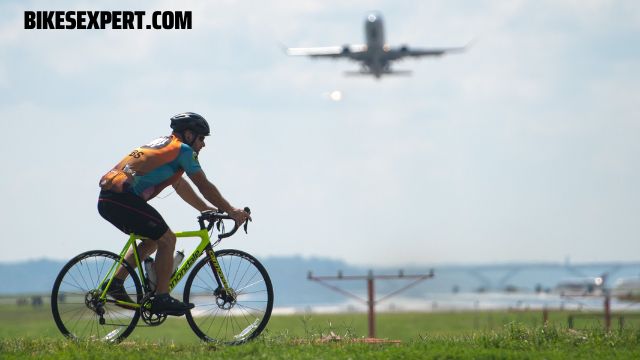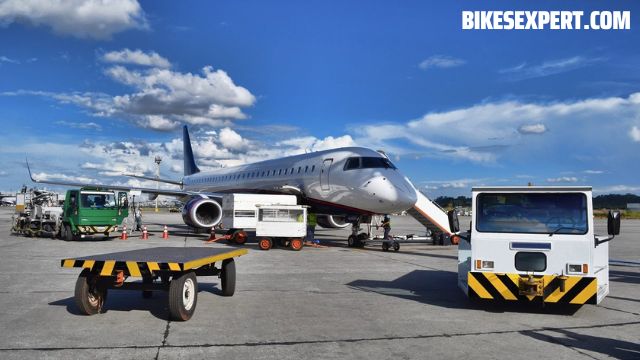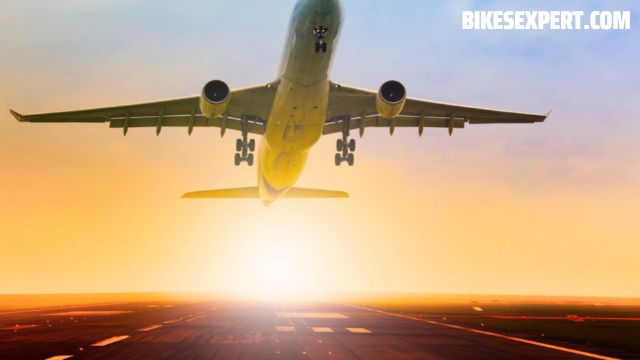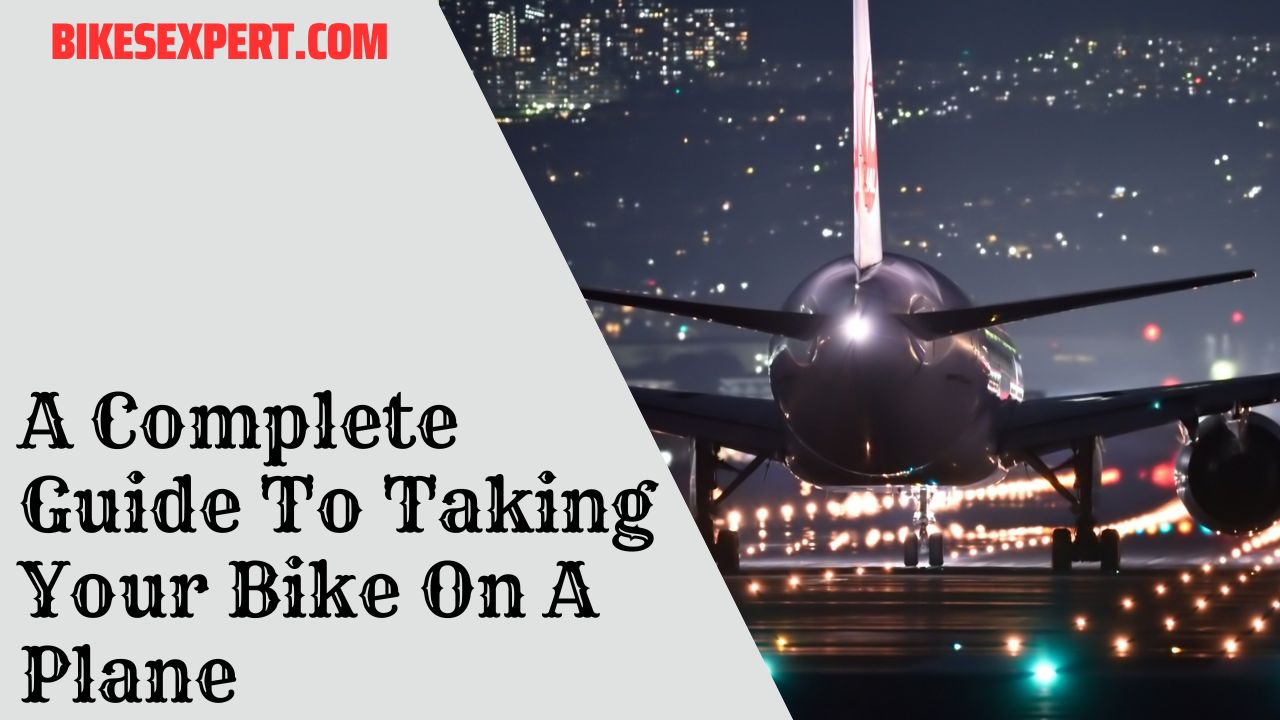Flying with a bike can be challenging. Most airlines allow bicycles on their planes and may include them in their standard baggage allowances. Rather than checking in a suitcase or backpack, you can check your bicycle as luggage.
When flying with a bike, you must follow your carrier’s rules and regulations. Airlines usually require that bikes be bagged or boxed. This requires deflating your tires, taking off the pedals, handlebars, and front wheels, and lowering the seat post of your bike. The next question you might have is:
- What are the best airlines for cyclists?
- How do I pack my bike into a box?
- And how much does it cost?
In this article, I’ll explain what to expect when flying with your bike so that you can focus on the fun part!
Also, make sure to check out my post on How To Fix A Creaking Bottom Bracket? A Comprehensive Guide.
What Is Airline Bike Policy?

When flying with a bike, it’s important to research your airline’s policies in advance. These policies can be found on the airline’s website under the ‘special baggage’ or ‘sporting equipment’ sections. Take a printout of the airline’s policies to the counter to ensure they will be honored.
The following are a few typical airline policies to keep in mind:
- It is necessary to make a reservation in advance.
- You need to know the maximum weight and size of your bike.
- You’ll have to pay an additional fee if you exceed the weight limit.
- The dimensions for several airlines are outdated. You shouldn’t be charged extra if your bike is in a standard bike bag or box.
How To Pack Your Bike For An Airline?

Before packing your bike for the airline, you need to know which bags or boxes you can use to pack your bike. You have three options for transporting your bicycle on a plane:
- Cardboard Bike Boxes
- Ctc Plastic Bags, And
- Dedicated Bike Bags.
Cardboard Bike Box
Many cycle shops offer free cardboard bike boxes. The cardboard box must fit your bike. Your bike’s pedals, front wheel, seat post, and handlebars must be removed to fit inside a box.
Place the front wheel beside the bike in the box and tape the handlebars to the frame. It is also a good idea to tape the pedals and seat post to the frame to prevent them from falling out if a hole rips through the box during transit.
Cardboard boxes make flying your bike very convenient in many ways. Almost anywhere in the world, these boxes can be obtained for free, so you can recycle the box once at your destination and buy a new one before you leave.
CTC Bike Bag
It is a heavy-duty polyethylene bicycle bag. With these bags, you won’t have to disassemble your bike much. The wheels and other parts shouldn’t need to be removed.
And you’ll need to deflate the tires, remove the pedals, and turn the handlebars inward. It also has the advantage of being see-through. Rather than stacking luggage on top of an anonymous cardboard box, handlers should treat the bike respectfully.
Tape the rear derailleur inside the chain stays and pipelag the frame tubes to protect the rear derailleur. It is important to know that not all airlines will accept these bags because they are too large or not adequately protected.
Dedicated Bike Bag
There are two kinds of bags available here: hard cases and soft bags. The former is more durable, lighter, and easier to store, while the latter is generally cheaper, lighter, and more durable.
A dedicated bike bag has padding in all the right places and is specifically designed to transport bikes. In some cases, airlines will not accept bikes unless they are packed in dedicated bike bags.
| Types of Bag | Benefits | Drawbacks |
| Cardboard Bike Box | Cycle shops offer these for free. These are accepted by many airlines. It is recyclable | Your bike might be damaged if cardboard boxes are stacked and heavy objects are piled on top of it. I find it very difficult to carry around |
| CTC Bike Bag | It doesn’t take much effort to dismantle your bike. As it is clearly a bike, handlers should be careful with it. It’s lightweight and foldable, making it easy to carry. The cost of buying is low. | The bag is not very protective in transit. Not all airlines will accept it. |
| Soft Bike Bag | During transit, bikes are protected from rubbing against other luggage. All airlines accept these. | During a tour, your bike case may need to be stored somewhere. It offers some protection. |
| Hard Bike Case | Hard bike bags protect your bike very well while in transit. These are accepted by all airlines. | Expensive When touring, you may need somewhere to store your bike case. |
The Dismantling And Packing Of Your Bike:

It is necessary to disassemble your bike after you have chosen the bike packing bag for transport.
- Getting ready for packing:
A pair of Allen keys, foam tubing, and packing tape will be needed.
Remove The Pedals:
Use a pedal spanner to unwind your pedals. Loosen the right pedal by rotating counterclockwise, and the left pedal by rotating clockwise.
- Remove the wheels:
The wheel may only need to be removed on one side.
- Deflate the tires:
Due to the pressure in the tires, airlines require you to deflate them.
- Remove the seat post/lower the saddle:
Make sure you mark the position of your saddle before reassembling your bike so you can easily find the right height. Depending on your situation, you may need to remove the seat post entirely or lower the saddle as low as it will go.
- Remove the handlebars:
Sometimes, you may even get away with just turning the handlebars inward.
- Remove the derailleur:
Tape the chainstays to the bag or box to keep the derailleur from hitting the sides. In transit, it is easily damaged.
- Protect with foam tubing:
Cover your frame, fork, and handlebars with a foam tubing to prevent damage. In the case of a hard bike case, this is not necessary.
How Much Does It Cost To Take Your Bike On A Plane?

It depends on the airline and the equipment you have. Some airlines don’t charge any extra fees for bikes, others charge all-inclusive fees for bikes, and some charge additional fees for weight, size, and size of luggage. Your airline’s policies will determine your expenses, but you can usually use this formula:
Bike Transportation Cost :
Bicycle Fee + Standard Checked Bag Fee + Oversize Fee (if applicable) + Overweight Fee (if applicable)
In most cases, airlines charge oversize fees if your luggage’s combined length, width, and depth exceed 62″. There are many popular bags and cases that exceed this limit, but airport security must enforce it more consistently.
Penalties for overweight baggage start at 50 pounds, and some airlines charge more if the bag weighs more than 50 pounds.
Overall, costs can vary dramatically. Bringing a lightweight road bike in a small, soft bag and flying on an airline without a bike fee will only cost you a standard check-in bag. A large mountain bike in a hard case may cost $300 or more each way on an airline that charges for bikes, weight, and oversize.
Flying With A Bike On The Best Airlines
Listed below are the bike policies of major airlines so that you can choose the best option for your next trip.
- There is a one-way fee
- Dimensions in linear inches are length + width + height
- The lithium batteries in e-bikes prevent them from being taken on airplanes
| Airlines Name | Bike Fee | Max Weight | Max Dimensions | overweight fee | Oversize Fee |
| Aero–mexico | In Mexico, $75 USD$150 USD Intern. | 32kg | (203-292 linear cm) | No | No |
| AirCanada | $50 USD | 32kg | 292 linear cm | No | No |
| Air France | $75-150 USD | 23kg | 300 linear cm | No | No |
| Alaska Airlines | Standard checked bag fees | Waived | Waived | No | No |
| American Airlines | Standard checked bag fees | 23kg | 320 linear cm | $150 – $200 | $100 |
| British Airways | Standard checked bag fees | 23kg | 350 linear cm | Uncertain. | €75/ $100USD |
| Delta | Standard checked bag fees | 23kg | 292 linear cm | $200 | $100 |
| Frontier | $75 | 45kg | 279 linear cm | No | No |
| Hawaiian Airlines | $35 – $150 | 23kg | 292 linear cm | No | $60-$150 |
| jetBlue | Standard bag fee + $100 USD | 45kg | 80 linear in | No | No |
| United Airlines | Standard checked bag fees | 23-32 kg | Waived | Varies | Varies |
| Spirit | $75 USD | Waived | Waived | No | No |
| Virgin Atlantic | Standard checked bag fees | 23kg | Not specified | $300 | $100 |
| WestJet | $50 CAD | 45kg | 292 linear cm | No | No |
| Southwest | $75 USD | 23kg | 157 linear cm | $75 | $75 |
Frequently Asked Questions [FAQs]
At this stage of the article, let’s see some FAQs, that people frequently ask about Taking Your Bike On A Plane.
Can I Take My BMX On A Plane?
Yes, you can take your BMX bike plane, but it is quite costly. To minimize the cost, you will need smart packing planning.
Is It Hard To Bring A Mountain Bike On A Plane?
Mostly, mountain bikes can be brought on an airline the same way as road or gravel bikes. Generally, mountain bikes are larger, with thicker tubes and wider axles. You may need a case or bag designed specifically for large bikes if your mountain bike will only fit into some travel cases.
How Much Does It Cost To Take A Mountain Bike On A Plane?
Some airlines allow you to check your bike for free as part of your free baggage allowance, while others charge you an additional fee. Depending on the airline, bike fees can range from US$40 to US$350 per flight leg.
Should You Deflate Bike Tires When Flying?
It is not necessary to deflate bicycle tires before flying .In flight, tire pressure does not create extra weight. Moreover, the possibility of tire shape deformation becomes less if tire pressure is not removed while flying.
What Is The Best Way To Fly With Your Bike?
The simplest way to transport your bike is in a cardboard box. At almost any bike shop, cardboard boxes are easy to find (often for free). Your bike can fit almost intact, so packing them is no problem.
Do Airlines Have Bike Boxes?
There are some airlines that provide bicycle boxes for a fee, but there are many that do not. Before you travel, contact the airport.

Final Words:
Flying with a bike can be a bit scary, but you will find it more convenient than you think. It is important to print out this document, follow the airline’s bike policy, and allow yourself extra time at the airport before you fly.
When packing your bike for a flight, you should ensure that it is packed in a proper manner to prevent damage to it.
Another post that will interest you is about How To Prevent A Flat Tire On Your Next Ride: Essential Tips And Tricks.




